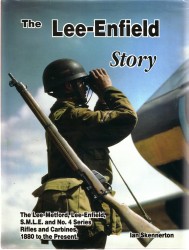Firearms Technical Trivia, February 2000:
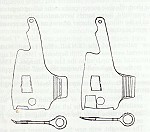 |
 |
 |
History provides much evidence of the temporal gap between the advent of a new martial technology, and the ability or willingness of a military organization to take advantage of or adapt tactics to that new technology. For example, during the American Civil War, generals versed in the tactics of the Napoleonic era continued to apply those tactics, despite the advent of the rifled musket which rendered the massed frontal assault little more than precursor to slaughter. During the First World War, the French sent wave after wave of infantry against German Maxim machine guns, relying on cran ("guts") and the bayonet to win the day. It didn't.
In the field of martial longarms there is ample evidence of this trend towards tactical conservatism. Perhaps nowhere is it more evident than a certain curiosity in the design of the first bolt action magazine repeating rifles adopted by major powers. Most, if not all of them were designed with devices designed to prevent cartridges from feeding from the magazine, so as to permit the rifle to be used as a single loader. These devices were called "magazine cut-offs." Many rifles used in conflicts as late as the Korean War still displayed this feature, or at least the mountings therefore. It is our intent to briefly cover the thought and theory behind these relics of 19th century military thinking that survived into the 20th century as well as to identify and explain some of the more common mechanisms used to achieve the cut-off effect.
Orthodox military thought at the latter part of the 19th century greatly feared the advent of the magazine repeating rifle and the erosion in fire discipline, and waste of ammunition that it would bring. The contents of the magazine were to be held in reserve and used only in an emergency. Illustrative of this train of thought is an appendix to a Report of the (British) Special Committee on Small Arms, written on January 13, 1887 by Colonel C.G. Slade, Commander, 2nd Battalion, Rifle Brigade:
The almost universal conversion of single loaders into magazine arms, or arms capable of being used at will as repeaters, will introduce a new element into fire tactics, but it may be doubted whether any change will consequently take place in these tactics, or if any such change would not be a step in the wrong direction.Colonel Slade's remarks are more useful to the historian and the cruffler when one takes into account that they accurately reflected the thinking in most of Europe and the United States at the time. The military, then, were far from convinced as to the utility of the magazine repeater. This had much to do with the fear that such an invention would create an attendant breakdown in discipline. Until the advent of the magazine repeater, the individual infantry soldier was only as effective as his unit. To make a unit effective, the individuals within it had to be subordinated, with respect to fire discipline, to that unit and its leaders. The very idea that an individual could attain some level of effectiveness threatened the very core of small unit discipline. So, while it was hard to dispute the utility of the magazine, conservative military thought dictated that it be adopted as a reserve capability.
Fire discipline, the necessity of controlling and steadying men firing, and thus preventing a wasteful expenditure of ammunition will be of just as much importance as ever.In a circular memorandum dated 2nd November 1886, His Royal Highness the Field Marshal Commanding in Chief directed that "Independent firing in the attack formation should be discontinued altogether and that in future, volley firing should be employed during all stages of the attack."
It is said that with the introduction of magazine arms a new system of fire discipline will come into play and that the soldier will be taught to load and fire from his magazine on all occasions. The command "fire one, two, or more shots" will be substituted for the caution "fire one, two, or more volleys." This would be simply re-introducing "Independent firing" with all its attendant evils.The magazine question is more or less a political one and the general conversion of single loaders into repeaters which is taking place all over Europe is due, not so much to the superiority of the magazine arm as to the feeling that it is necessary to keep abreast of one's neighbours.
An examination of the state of affairs both at home and abroad shows clearly that the weapon of the future has yet to be found.
There was no uniformity as to how the various cut-offs achieved the effect of permitting the use of the rifle as a single loader while holding the contents of the magazine in reserve. We'll look at two of the most popular mechanisms, the plate and the spindle, and their application in several rifles that served well into the the 20th century.
LEE-ENFIELD,
Plate Mechanism
A cut-off
was incorporated into the mechanism of the first Lee type rifle (the Lee-Metford)
adopted by the British military in December 1888. This cut-off mechanism
remained basically unchanged and continued to be incorporated into each
successive iteration of the Lee rifle until it was finally deleted with
the approval of the Mark III* Short Magazine Lee Enfield (SMLE) on January
2nd, 1916. Old paradigms die hard, however, and it should be noted
that the omission of the cut-off was not necessarily a feature of the Mark
III*, and that the cut-off was reinstated after the First World War for
mounted forces and certain other units. In fact, post-war developments
of the SMLE (the Marks V and VI) incorporate the cut-off, and even the
trials No. 4 Mark I in 1933 was equipped with a cut-off.
| The Lee-Enfield cut-off system consisted of a slot milled into the right side of the receiver, and an associated flat spring steel plate that was roughly triangular in cross section. At the forward edge of the slot was a vertical threaded hole. The forward edge of the plate (the acute angle) had a corresponding hole. A screw passed through these holes, both securing the cut-off to the receiver, and providing a pivot axis for the cut-off. The cut off |
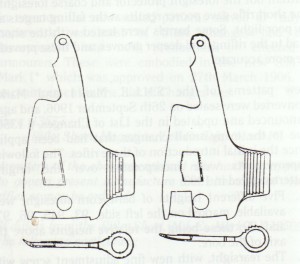 Image Credit: Skennerton, Ian D, The Lee-Enfield Story, IDSA Books (Picqua, Ohio, 1993) Page 113 |
KRAG-JORGENSEN,Spindle
Mechanism
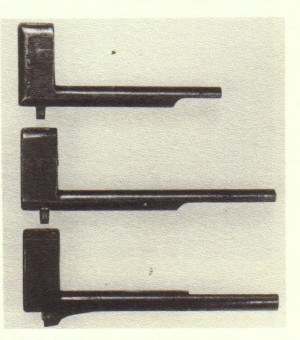
Image Credit: Brophy, Lt. Col. William S., The Krag Rifle, The Gun Room Press (Highland Park, New Jersey, 1995) Page 31 |
The Krag-Jorgensen rifle was adopted by the United States in 1892. This rifle represented quite a number of firsts for the United States Army. It was the first small bore smokeless powder magazine repeating arm adopted by the United States. And it was the first United States rifle to incorporate a magazine cut-off. The cut-off was of the spindle type and was located on the left side of the receiver. The spindle was a steel rod with a flat thumb piece at the rear, and a milled portion at the front with a hemispherical cross section, called the spindle point. When the thumb piece is turned down the spindle point lies entirely within the milled recess in the left wall of the receiver. |
M1903 SPRINGFIELD, Spindle Mechanism
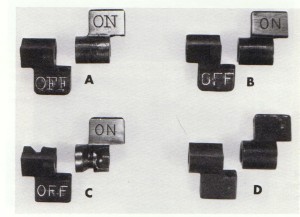
Image Credit: Brophy, Lt. Col. William S., The Springfield 1903 Rifles, Stackpole Books (Mechanicsburg, Pennsylvania, 1985) Page 46 |
The replacement for the Krag-Jorgensen rifle in United States service, the M1903 Springfield rifle retained the functions of the cut-off, while changing the nature of the way the cut-off functioned. The cut-off in the Springfield is positioned at the rear left side of the receiver, and consists of a collar and a thumb piece. The collar is milled such that a concave surface is milled off the round collar. When the thumb piece is turned down, the magazine is in |
TURKISH MAUSER MODEL 1893, Lever Mechanism
| As a general rule, smokeless powder Mauser magazine repeating rifles were not manufactured with magazine cut-offs. The Turkish Model 1893 was an exception to this rule. The cut-off on this rifle was located on the right side of the central portion of the receiver. The cut-off itself consisted of a spring actuated lever pivoted in the right side of the action. When it was engaged, it held the cartridge column in a slightly |
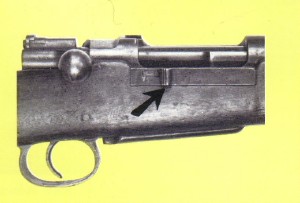 Image Credit: Olson, Ludwig, Mauser Bolt Rifles, Brownell & Son (Montezuma, Iowa, 1991) Page 71 |
Though the cut-off was a vestige of 19th century military tactics and thought, it survived until the middle of the 20th century, from approximately 1880 to the late 1950's. And while it may seem inconsequential, this device had a longer service life than many types of 20th century arms; the submachinegun saw front line service for barely thirty years; the self-loading battle rifle for barely forty.
Interestingly, many assault rifles have mechanisms for shutting off the gas system . And so, the cut-off survives in many different forms into the current day. In doing so, it may just be the longest lived feature of modern military longarms. Not bad for a 19th century anachronism!
Note: Data for this month's trivia page was gathered from:
Brophy, Lt. Col. William S., The Krag Rifle, The Gun Room Press (Highland Park, New Jersey, 1985) ISBN 0-88227-025-7
Brophy, Lt. Col. William S., The Springfield 1903 Rifles, Stackpole Books (Mechanicsburg, Pennsylvania, 1985) ISBN 0-8117-0872-1
Olson, Ludwig, Mauser Bolt Rifles, Brownell & Son (Montezuma, Iowa, 1991)
Skennerton, Ian D., The Lee-Enfield Story, IDSA Books (Picqua, Ohio, 1993) ISBN 1-85367-138-X
The
Krag Rifle is available from IDSA Books. Click on the image
to order:
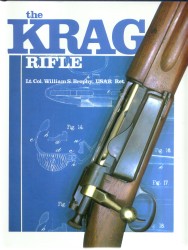
The
Springfield M1903 Rifles is available from Brownells. Click
on the image to order:
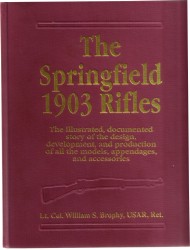
Mauser
Bolt Rifles is available from Brownells. Click on
the image to order:
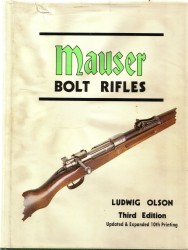
The
Lee-Enfield Story is available from IDSA Books. Click on
the image to order:
